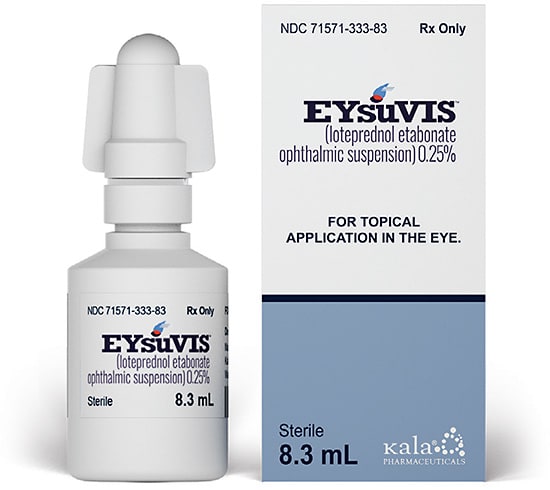Short-term treatment quiets intense symptoms
EYSUVIS (loteprednol etabonate ophthalmic suspension) 0.25%, from Kala Pharmaceuticals, utilizes the company’s AMPPLIFY mucus-penetrating particle (MPP) drug-delivery technology to enhance penetration and distribution of loteprednol etabonate (LE) into target tissues on the ocular surface, specifically the cornea and conjunctiva. EYSUVIS works by targeting the innate and adaptive immune responses that cause dry eye flares in the first place.
Shifting Mindset to Treat Earlier
“I appreciate the fact that it’s a short course treatment,” says Francis S. Mah, MD, director, cornea service, co-director, refractive surgery, Scripps Clinic in La Jolla, Calif. “As corneal specialists, we’re always looking at IOP spikes, but the fact that EYSUVIS is a short-term treatment mitigates those issues. Also, the current recommended dosing—four times a day for two weeks—is easy for patients to remember. As with any new treatment option, I think we’ll learn more independently as we go.”
Dr. Mah notes he is seeing more dry eye patients than ever—both existing patients with new flares, as well as patients with brand-new dry eye symptoms.
“Prior to this FDA-approved option, we were recommending at-home treatments and being more of a cheerleader in supporting what patients were doing on their own, even if they were already on chronic therapy,” Dr. Mah says. “Now, we have something more definitive to offer in advance of initiating chronic therapy to relieve such dry eye flares. I can see EYSUVIS being used as a first-line treatment for those patients who only have occasional dry eye flares, as well as a first-line therapy in those patients newly diagnosed with dry eye before a more chronic therapy might have to be considered, in addition to those patients with known dry eye on chronic therapy. Finally, it might be started along with chronic therapy as induction therapy.”
Being Proactive in Response to Dry Eye Triggers
Eric Donnenfeld, MD, founding partner, Ophthalmic Consultants of Long Island, NY, and clinical professor of ophthalmology at New York University, says EYSUVIS provides a solution for patients who might be going to an environment, such as to the mountains for a ski trip, that will inevitably cause dry eye flares.
“Many of these patients, will have waxing and waning flares during the course of the year, and this new therapy will provide an additional treatment option,” he explains. “It can be layered on top of immunomodulation. I also like to use it for patients in whom I am doing induction therapy.
I have patients who have burning or irritation with one of the topical immunomodulators or who don’t want that long waiting period in order to have relief, so, I have used EYSUVIS in conjunction with a chronic therapy for breakthrough symptoms when there is a dry eye flare.”

Preparing the Ocular Surface: Pre-Cataract Surgery
Dr. Donnenfeld says he has also found EYSUVIS to be useful for rapid rehabilitation prior to cataract surgery. “I don’t have to delay a surgery because of the speed at which EYSUVIS is able to improve the ocular surface,” he explains.
The FDA granted approval to EYSUVIS based on the results of three Phase 3 trials and one Phase 2 trial, which demonstrated significant improvements in both the signs and symptoms of dry eye disease. EYSUVIS was shown to be well-tolerated with adverse events and IOP increases comparable to that observed with vehicle.
Meeting a Need
Karl Stonecipher, MD, medical director of Physicians Protocol and Laser Defined Vision, Greensboro, NC, says he has numerous patients who are using a topical immunomodulator for dry eye but still need an anti-inflammatory that can deliver fast-acting control during an episodic flare. EYSUVIS has met this need, he says.
“A classic example for use would be one of my Sjögren’s syndrome patients. The drug becomes a great product for control,” he says. “It’s a new opportunity to treat patients acutely with a proven delivery system that will get the active ingredient directly to the treatment site.” CP














